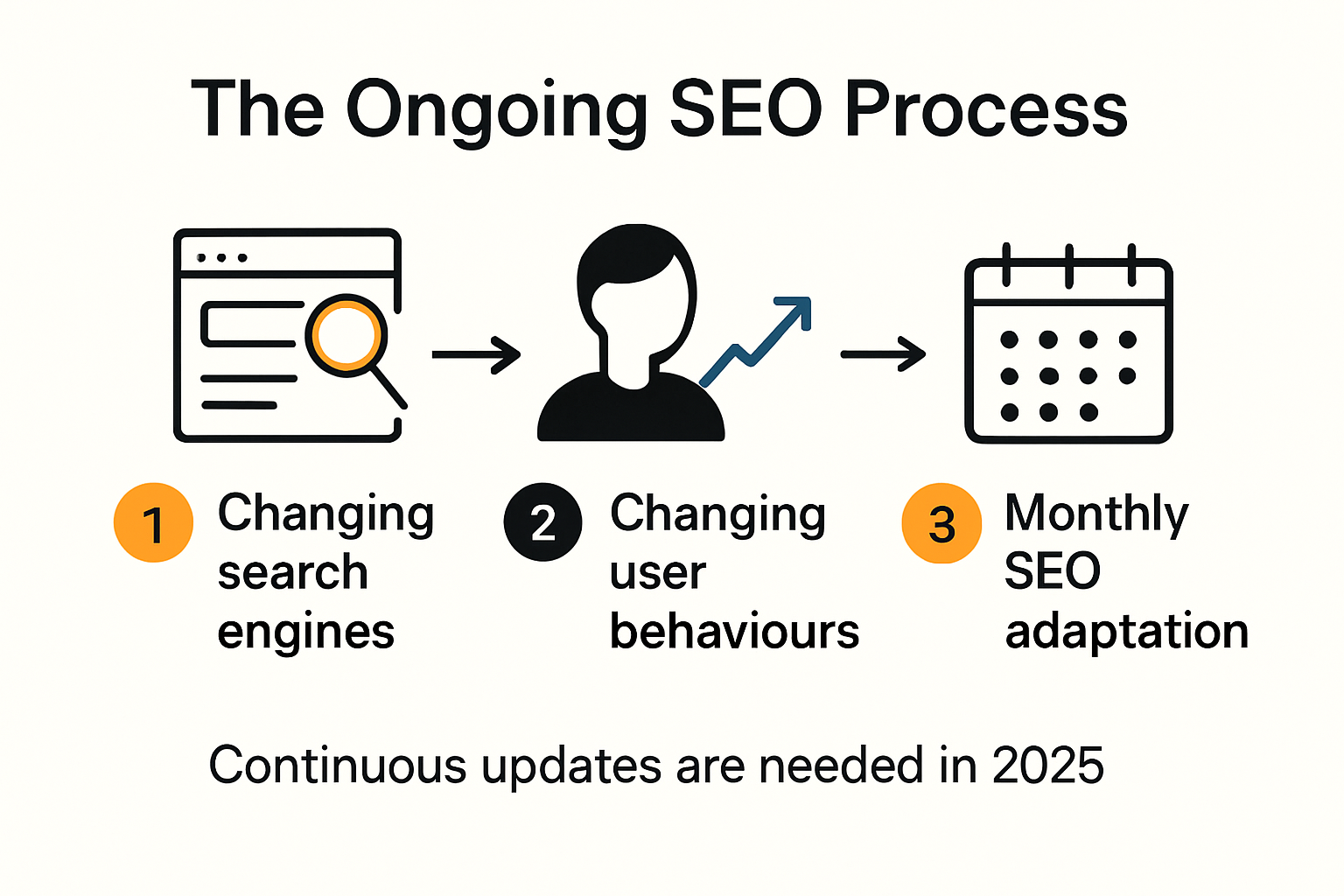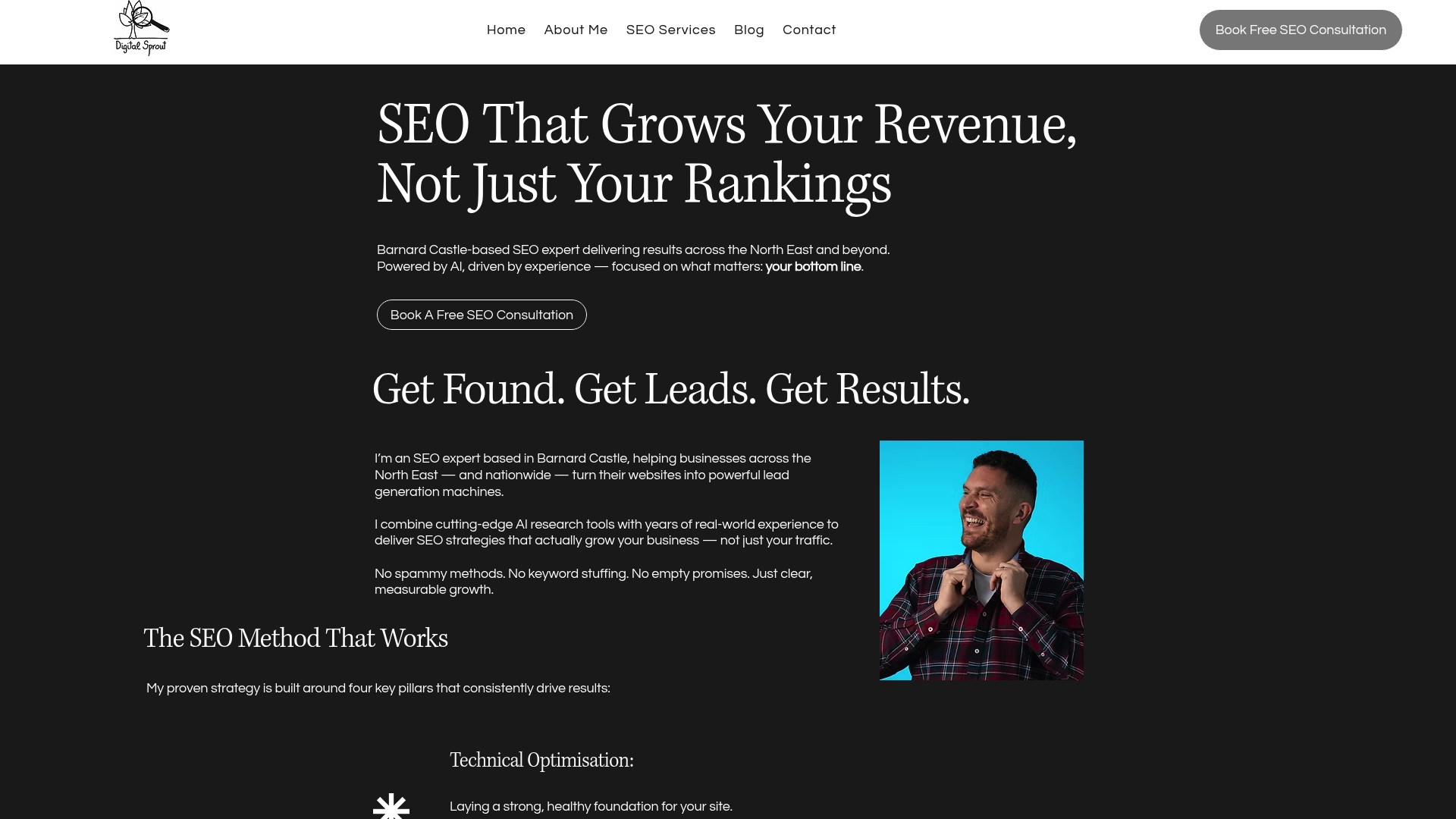Why SEO Needs Ongoing Work: Essential Strategies for 2025
- Mike Dodgson

- Jun 28
- 8 min read
Updated: Jun 30
SEO used to be about ticking boxes and climbing keyword charts, but that no longer fits the digital world of 2025. Search platforms have scattered, and now Google’s share of the market has dropped to 83 percent. Surprised? Most people expect Google to rule unchallenged, yet it is the pace of user behaviour and algorithm evolution shaking everything up. The real secret is that static strategies and periodic check-ups cannot keep up—now, the only way to stay seen online is to treat SEO as an ongoing, intelligent process of learning and adapting every single month.
Table of Contents
Quick Summary
How Search Engines and User Behaviour Change
Search engines are undergoing a radical transformation in 2025, driven by sophisticated artificial intelligence and increasingly complex user expectations. The traditional approach of keyword matching is rapidly becoming obsolete, replaced by more nuanced algorithms that prioritise user intent and contextual understanding.
The Evolution of Semantic Search
In 2025, search engines have become remarkably intelligent at interpreting user queries beyond literal text. According to Google’s AI Research Team, semantic search now goes far beyond simple keyword recognition. These advanced systems analyse the entire context of a search, understanding subtle linguistic nuances, user intent, and even potential underlying motivations.
For businesses, this means creating content that genuinely answers user questions becomes paramount. Search algorithms now reward depth, relevance, and comprehensive information that directly addresses user needs. This shift demands a more sophisticated content strategy that anticipates user questions and provides comprehensive, authoritative responses.
User Behaviour Transforming Search Dynamics
User search behaviour has dramatically changed, becoming more conversational and specific. Research from Gartner Digital Markets reveals that users now expect personalised, immediate, and highly relevant search results. Voice search and AI assistants have fundamentally altered how people interact with search platforms, making natural language processing increasingly critical.
Businesses must adapt by developing content that feels conversational and directly addresses specific user queries. This means moving away from keyword stuffing and towards creating genuine, helpful content that speaks directly to user needs. Learn more about optimising your approach with our strategic SEO ranking guide.

The search landscape of 2025 demands continuous adaptation. Machine learning algorithms now track user engagement metrics with unprecedented precision. Factors like time spent on page, interaction depth, and content relevance are weighted more heavily than ever before. Search engines are essentially becoming intelligent systems that learn and evolve in real-time, rewarding content that genuinely serves user needs.
For organisations wanting to remain visible online, this means SEO is no longer a static strategy but a dynamic, ongoing process of understanding and anticipating user behaviour. Successful digital strategies will require constant monitoring, rapid adaptation, and a deep commitment to creating truly valuable content that resonates with target audiences.
The message is clear: static, keyword-focused content is dead. Long live dynamic, user-centric, intelligently crafted digital experiences.
Competitor Activity and Industry Trends
In the rapidly evolving digital marketplace of 2025, understanding and anticipating competitor activity has become a critical component of successful SEO strategy. Businesses can no longer rely on static approaches or assume their current market position is secure.
The Shifting Competitive Landscape
According to Exposure Ninja’s Digital Trends Report, the search engine market is experiencing unprecedented fragmentation. Google’s market share has dropped from 86% in May 2023 to 83% in May 2024, signalling a significant shift in how users discover online content. This transformation demands a more dynamic approach to competitive analysis.
Businesses must now track not just traditional competitors, but also emerging digital platforms and AI-driven search technologies. Competitive analysis in 2025 now requires a multi-dimensional approach that goes beyond simple keyword tracking. Companies that successfully optimized their strategy based on comprehensive competitor analysis saw up to a 30% increase in organic traffic within six months.
Emerging Trends and Strategic Adaptation
The SEO industry is witnessing a fundamental restructuring of competitive dynamics. Research from Digital Marketing Insights highlights three critical areas businesses must monitor:
- Keyword Gaps
: Identifying unexplored content opportunities
- Backlink Profiles
: Understanding strategic link-building approaches
- Content Strategies
: Tracking innovative content development techniques
Our strategic SEO ranking guide provides deeper insights into navigating these complex competitive landscapes.

The rise of AI-powered search platforms like ChatGPT, Perplexity, and Gemini has created an entirely new competitive dimension. Traditional SEO metrics are no longer sufficient. Businesses must now develop content strategies that can perform across multiple discovery channels, each with its unique algorithmic preferences.
Successful organisations in 2025 recognise that competitive SEO is not about mimicking competitors, but about understanding the broader ecosystem. This means developing agile strategies that can quickly adapt to technological shifts, user behaviour changes, and emerging search platforms.
Continuous monitoring is no longer optional - it’s a fundamental requirement for digital survival. Companies that fail to invest in ongoing competitive analysis risk becoming invisible in an increasingly fragmented digital marketplace. The most successful businesses will be those that view SEO as a dynamic, intelligent process of constant learning and adaptation.
Technical SEO and Content Maintenance Essentials
In the complex digital ecosystem of 2025, technical SEO has transformed from a background task to a critical ongoing process. Businesses must recognise that website performance is not a one-time configuration but a continuous journey of optimization and refinement.
Core Web Vitals and Performance Optimization
According to Obergine’s Technical SEO Insights, Google’s Core Web Vitals have become the cornerstone of technical SEO performance. Metrics like First Input Delay (FID), Largest Contentful Paint (LCP), and Cumulative Layout Shift (CLS) are now fundamental ranking factors that directly impact user experience and search visibility.
Website owners must implement rigorous, ongoing monitoring of these performance indicators. This means regular audits, immediate issue resolution, and proactive optimization strategies. Technical performance is no longer a background consideration but a primary driver of search engine rankings and user engagement.
Site Structure and Crawl Efficiency
Research from Riman Agency highlights the critical importance of site structure in 2025. Ensuring all important pages are within three clicks from the homepage and implementing clear breadcrumb navigation can dramatically improve crawl efficiency. One news website experienced a remarkable 25% increase in session duration after implementing these technical improvements.
Technical maintenance now requires addressing complex issues like JavaScript rendering, identifying and resolving orphan pages, and ensuring seamless indexing. Learn more about crafting effective website content with our comprehensive guide for modern businesses.
The same research revealed that resolving JavaScript-based navigation issues can increase organic traffic by up to 30%. This underscores the need for continuous technical optimization beyond traditional SEO practices.
Businesses must develop a systematic approach to technical SEO that goes beyond periodic checks. This involves:

Regular performance audits
Immediate resolution of crawl and rendering issues
Continuous site structure optimization
Proactive adaptation to evolving search engine algorithms
The most successful digital strategies in 2025 treat technical SEO as a living, breathing aspect of online presence. It requires dedicated resources, ongoing attention, and a commitment to understanding the intricate relationships between website architecture, user experience, and search engine algorithms.
Technical SEO is no longer a technical afterthought but a strategic imperative. Those who view it as an ongoing process of refinement and adaptation will find themselves at a significant competitive advantage in the increasingly complex digital marketplace.
Measuring Results and Adapting Your Strategy
In the dynamic digital ecosystem of 2025, measuring SEO performance is no longer a passive activity but an active, strategic process of continuous learning and adaptation. Businesses must develop sophisticated approaches to tracking, analyzing, and responding to their digital performance metrics.
Performance Metrics and Data-Driven Insights
Research from Digital Commerce Partners highlights the critical importance of ongoing measurement and strategic adaptation. Successful organisations now treat SEO analytics as a real-time strategic tool, not just a retrospective reporting mechanism.
Key performance indicators in 2025 extend far beyond traditional metrics. Businesses must now track:
Organic traffic quality and engagement
Conversion rates across different user segments
Keyword ranking volatility
Content performance across multiple discovery platforms
Learn more about tracking your SEO performance with our practical guide to understand how these metrics interconnect and drive strategic decision-making.
Strategic Adaptation and Continuous Improvement
According to TDMP Insights, successful SEO in 2025 requires a proactive approach to performance monitoring. This means developing robust systems that can:
Quickly identify performance trends
Rapidly prototype and test new content strategies
Swiftly respond to algorithm changes
Continuously refine targeting and messaging

North Core’s Business Trends Report emphasizes that businesses must conduct routine content and SEO performance audits. These aren’t just checkboxes but sophisticated analyses that provide actionable insights for strategic refinement.
The most effective organisations treat their SEO strategy as a living, breathing ecosystem. They understand that data is not just about measurement but about narrative - understanding the story behind the numbers and using those insights to drive meaningful change.
This approach requires more than just technical skills. It demands a holistic view that combines data analysis, creative problem-solving, and a deep understanding of user behavior. Businesses must invest in tools, talent, and processes that enable this level of strategic agility.
In 2025, SEO is no longer about achieving a static ranking but about creating a dynamic, responsive digital presence that can evolve in real-time. Those who master this approach will not just survive but thrive in an increasingly complex digital marketplace.
Frequently Asked Questions
What is the importance of ongoing SEO work in 2025?
Ongoing SEO work is crucial in 2025 due to rapid changes in user behaviour, search engine algorithms, and increased competition. Businesses need to continuously adapt their strategies to remain visible and relevant in an evolving digital landscape.
How does user behaviour affect SEO strategies?
User behaviour has shifted towards more conversational and specific queries, often driven by AI and voice search. SEO strategies must focus on understanding user intent and providing nuanced, high-quality content that directly addresses these needs.
What are Core Web Vitals and why do they matter for SEO?
Core Web Vitals are essential performance metrics that measure user experience on a website, focusing on loading speed, interactivity, and visual stability. They are crucial for SEO as they directly impact search rankings and user engagement.
How can businesses measure their SEO performance effectively in 2025?
Businesses can measure SEO performance by tracking metrics such as organic traffic quality, conversion rates, keyword ranking volatility, and content performance across various discovery platforms. Regular performance audits and data analysis are vital for ongoing strategy refinement.
Ready For Search Uncertainty? Outpace Competitors With Ongoing SEO That Works
If you are feeling overwhelmed by the constant shifts in search engines, algorithm updates, and new user search habits described in this article, you are not alone. Many businesses fall behind because they treat SEO as a one-off task instead of an ongoing investment. The reality in 2025 is harsh. Static SEO strategies are a recipe for lost rankings, invisible content, and wasted traffic. You need a practical partner who does more than chase keywords. You need measurable growth driven by real expertise.
Take control of your online presence and turn uncertainty into opportunity. Discover how Digital Sprout transforms fragmented SEO into a tailored, ongoing solution for businesses who want to win in today’s ever-changing search arena. Visit Digital Sprout to work directly with a senior SEO consultant who matches strategies to your commercial goals. Want proven monthly improvements? Explore our guides on SEO ranking factors for 2025 and tracking SEO performance to see the difference our approach can make. Take action now and put lasting growth at the heart of your digital strategy.
Recommended Articles
- On-page SEO Techniques for Business Growth in 2025
- SEO Strategy Planning Guide for 2025
- Scaling SEO Efforts Effectively in 2025
- How SEO Works and How to Improve Your Rankings 2025
- SEO Content Optimisation 2025: Strategies For Growing Your Business
- SEO for Beginners 2025: A Practical Guide for Business Owners
.jpg)


